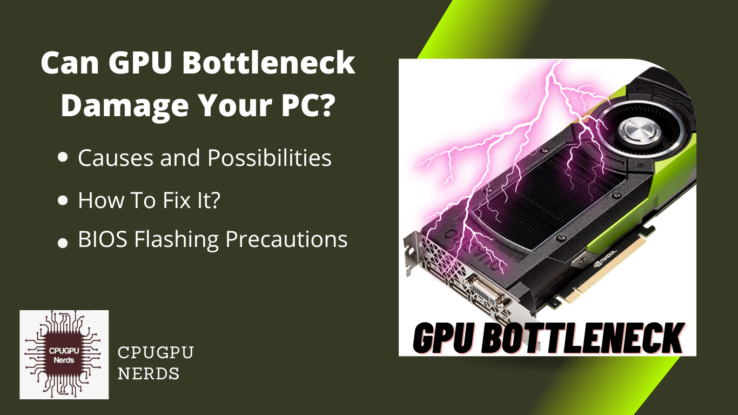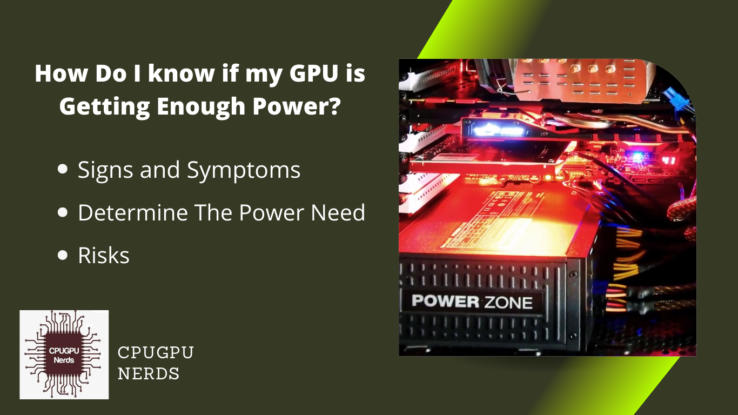Your computer’s Graphics Processing Unit (GPU) is an essential part of the system for rendering images on your screen. But what happens if your GPU can’t keep up with the demands of the game or application you’re using? Can GPU Bottleneck Damage Your PC? In this blog post, we’ll look at how a GPU bottleneck can affect your system and what you can do to prevent it.
But what exactly is a GPU bottleneck? When a system’s output is capped by its weakest link, we say it is experiencing a bottleneck. This is mostly due to insufficient RAM or a slow graphics card. When the graphics processing unit (GPU) slows down, it can affect performance across the board and possibly damage the rest of your hardware.
Can GPU Bottleneck Damage Your PC?
There is no doubt that a GPU bottleneck can damage your PC. The severe bottleneck can cause your system to overheat, potentially leading to hardware failure. In less extreme cases, it can slow down your system and make games or other resource-intensive applications unplayable.
Your computer’s GPU directly interacts with your computer’s RAM and processor, so when it cannot keep up with the system’s demands, it can cause bottlenecks that reduce overall performance. A permanent display problem could result from this performance lag or bottleneck. Here are some significant damage caused by the CPU bottleneck:
Display Damage
A GPU bottleneck can cause your monitor to display visual artifacts such as screen tearing or stuttering. These artifacts are caused by the GPU’s inability to keep up with the monitor’s refresh rate and can be very annoying. This damage gradually increases with time, and you often don’t notice what’s happening. In the end, you lost your GPU.
CPU Damage
Another potential damage caused by a GPU bottleneck is to the CPU. If the CPU is not being utilized properly, it can overheat and be damaged. In some cases, the CPU may even be throttled back to prevent damage.
Although the CPU is not directly connected to the GPU, they both function by sending and receiving commands and data. However, if the GPU displays incorrect temperature fluctuations, the CPU must increase the fan speed to prevent heat damage, which may ultimately harm the system.
Motherboard Damage
The motherboard is another piece of hardware that a GPU bottleneck can damage. If the GPU is not sending the correct data to the motherboard, it can cause the motherboard to overheat or short circuit, resulting in permanent motherboard damage.
Additionally, it will cause harm to other components, such as the hard disc, solid-state drives, and so on. Because it is the most crucial component of your computer, the motherboard will likely suffer direct consequences of any damage sustained by the system.
Is Bottleneck Bad For GPU?
Since we’ve shown that a GPU bottleneck might cause problems for your computer, you might be asking whether or not it’s harmful to the GPU component itself. There is no doubt that a bottleneck is terrible for your GPU because it can shorten its lifespan and, in some cases, even void the warranty. This is a severe problem.
Your games may not be playable if they run more slowly than they should due to a GPU bottleneck, which may also cause them to run more slowly. In the worst possible scenarios, a bottleneck could bring about the complete failure of your system.
Therefore, even though a bottleneck might not adversely affect your computer in and of itself, it is unquestionably something you want to steer clear of if possible.
What Are the Possibilities of a GPU Bottleneck?
GPU bottlenecks can occur for a variety of reasons. It can either be a severe one or a moderate one. Here, we will discuss some possibilities.
Overheating
Your system may overheat due to a severe bottleneck, which may ultimately break down some of its components. It can slow down your system to the point that it is unusable, rendering games and other resource-intensive applications unusable.
Consistently causing harm to the component over time, overheating constantly has that effect. Closely checking the component’s temperature can allow you to get around this problem. Utilizing temperature monitoring software like CoreTemp and MSI afterburner is the most effective method for accomplishing this goal.
Using Old GPU
An outdated or weak graphics card is a critical factor contributing to a GPU bottleneck. The more demanding games and other apps grow, the more power they require from the graphics processing unit (GPU). If your graphics card needs to be more powerful for the job, it will slow down the rest of your system and diminish its overall performance.
Low-End CPU
A CPU with fewer features is another option to consider. A central processing unit (CPU) that is not sufficiently powerful will need help to keep up with the demands of a high-end graphics processing unit (GPU). Because of this, your system may have a bottleneck, which will bring about a decline in its overall performance.
Bricked During BIOS Update
This is the most important point because this is a common mistake that can damage our system. If something goes wrong while updating the BIOS, it will result in a bricked GPU. A bricked GPU cannot be used and must be replaced.
If the GPU is not updated properly, it will cause serious issues like bottlenecks. So, be very careful while updating the BIOS and use only the official BIOS from the manufacturer to update it. The best way is to follow the manufacturer’s guide or contact the professionals for this work.
How To Fix The GPU Bottleneck? | Solution
Is the GPU bottleneck curable? There are certain situations in which you can recover your graphics card. Here, we have listed all possible solutions to recover a GPU from a GPU bottleneck:
Replacing the Graphics Card
The bottleneck is often permanent and may occur again and again if a GPU is damaged. The main reason is the GPU’s damage, whether electrical or physical. So, the best way to deal with the GPU bottleneck is to replace the entire graphics card with a more powerful one.
This will eliminate the bottleneck and allow your system to run at its full potential. If you want to upgrade your graphics card, be sure to research and choose a card that is compatible with your system.
Overclocking the Graphics Card
Overclocking is increasing the clock speed of a component beyond its factory-set limits. The Overclocking enables the component to run at its total capacity. Overclocking a graphics card can often lead to increased performance, which may help eliminate bottlenecks.
However, it is essential to note that overclocking comes with its risks. If done improperly, it can damage your components or lead to other problems. As such, it is essential to research the risks and rewards of overclocking before taking the plunge.
Reinstalling the Graphics Drivers
If you are using an outdated or corrupted graphics driver, it can often lead to a bottleneck. As new games and applications are released, they often require the latest drivers to function properly. As such, keeping your driver’s license up to date is important.
You can typically find the latest drivers for your graphics card on the manufacturer’s website. Choose the driver compatible with your specific graphics card and operating system model. Otherwise, you will need help getting the performance or display.
You should be able to get the most recent drivers for your graphics card from the website of the company that manufactured your graphics card. Carefully select a driver that is appropriate for the current version of your operating system and the graphics card connected to your computer.
Lowering the Graphics Settings
If you don’t have other options, you may need to lower the graphics settings in your games and applications instead of using this GPU. Lowering overall graphic settings will enable them to run without overburdening your GPU, which should help to eliminate the bottleneck.
Of course, this could be better, as it will likely lead to a decline in image quality. However, this method is not the permanent Solution to your problem, but if you’re looking to eliminate a bottleneck, it is often a necessary trade-off.
These are some solutions to fix the GPU bottleneck. Be sure to try all of them before giving up hope. GPU bottlenecks can be frustrating but can be fixed with patience and effort.
Conclusion
A GPU bottleneck will almost always result in a drop in speed and may cause your machine to get damaged. Nevertheless, a few things can be done to rectify the situation. Changing your graphics card is the most effective technique to eliminate a bottleneck in your system.
However, if that is not possible, try reinstalling your drivers or increasing the clock speed of your graphics card. The graphics settings in your games and applications need to be adjusted downward.

Hey, I’m Hammad. I write for this website to help you with the IT advice about PC, RAM, CPU, Motherboard, PSU, and other PC components.
I will provide detailed guides with images, and explain step by step so you can understand the process. Check all my articles here.



